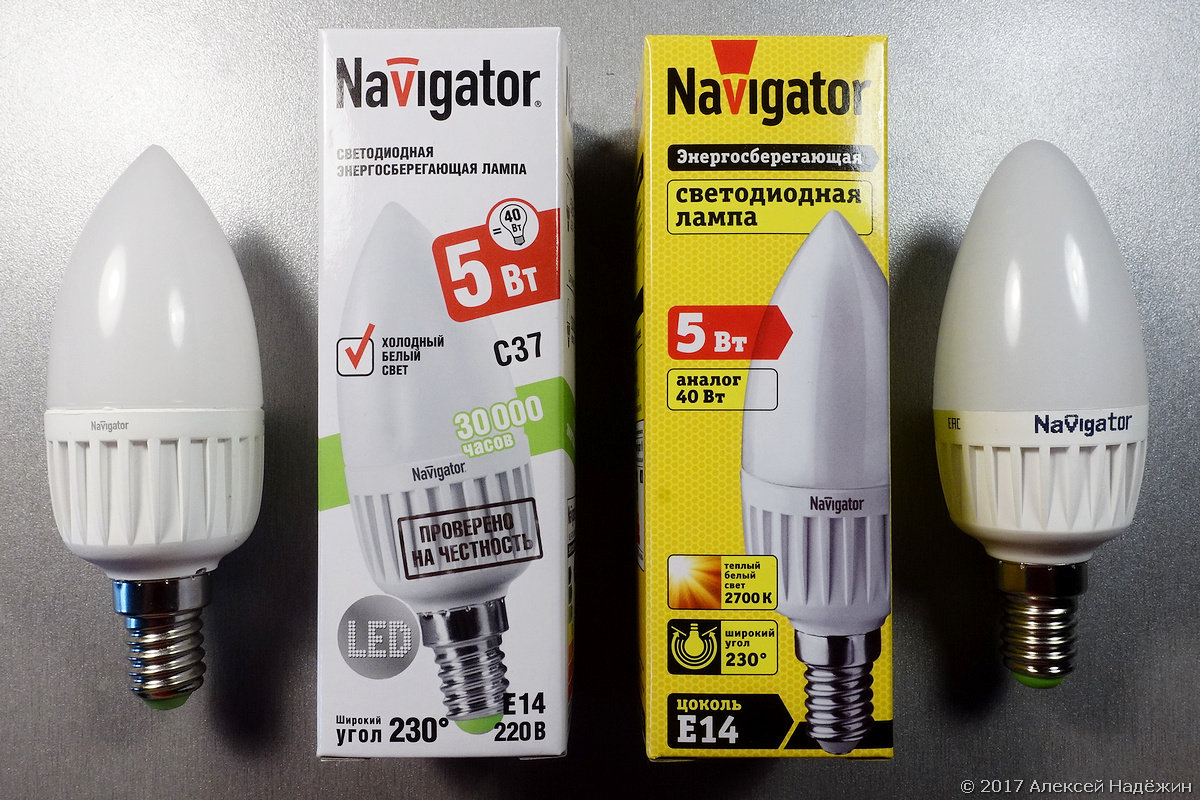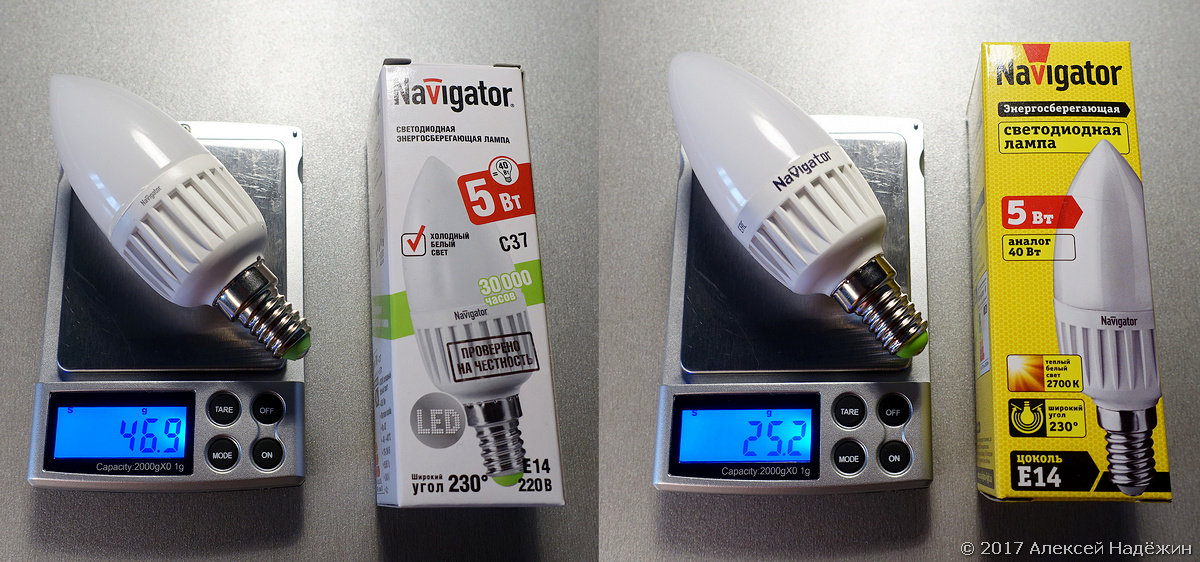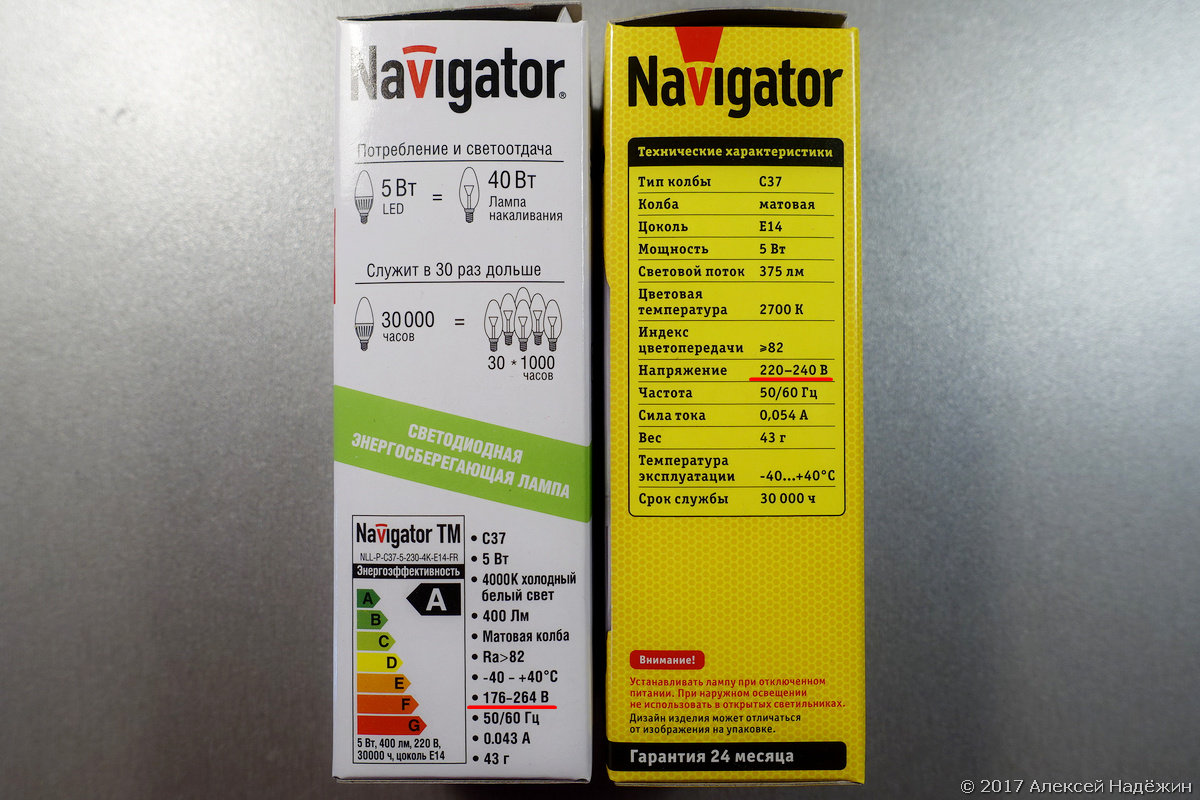The lamps are not the same
Project lamptest.ru there for three years. Recently, I started receiving messages from those who recently bought Navigator, Gauss, Wolta lamps, which, despite the same part number and the same bar code, are clearly not the ones I tested in 2014.
I tested the Navigator 2016 lamps and compared them with old lamps.

It turned out that in order to make the lamps cheaper, manufacturers went for substantial simplifications and deterioration.
Previously, Navigator lamps were sold in white boxes. The last batch of such lamps was produced in January 2016 and is also on sale. Now lamps are sold in yellow boxes. If you take the lamps in your hands, you immediately feel how much the lamps from the yellow boxes are lighter.
')

"Candle" 5 watts out of a white box - 47 grams, "Candle" 5 watts out of a yellow box - 25 grams.
All the old Navigators had a working voltage range of 176-264 volts, on the new ones 220-240 volts are indicated and this is not an accident.

The old lamps use an IC driver that allows the lamp not to change the brightness over a wide voltage range. According to my tests, the lamp in the white box does not reduce the brightness when the mains voltage drops to 114 volts. The new lamps are equipped with a cheap linear driver and the lamp brightness decreases with decreasing supply voltage. When the network voltage drops to 216 volts, the brightness drops by 10%.
This means that it is undesirable to use new lamps where there is undervoltage and where there are voltage drops - the light will dim and blink. The old lamps in the same conditions are stable at maximum brightness and the light does not flicker when the voltage drops.
Another side effect of the linear driver is that if the lamps are connected through a switch that has an indicator, the lamps will glow weakly when the switch is turned off.
Most Navigator lamps in white boxes have a ripple of light that does not exceed 5%, almost all lamps in yellow boxes have a ripple of about 25%. It is almost imperceptible "by eye", but still speaks of the lower quality of the light of new lamps.
The new lamps saved on the driver and, judging by the weight, on the radiator, but the LEDs remained good - the color rendition index of all the lamps, except G4 / G9, is above 80.
The new lamps Wolta saved on LEDs.
Previously, Wolta lamps were sold in clear plastic boxes. Almost all such lamps have a CRI of more than 83, now the lamps are sold in cardboard boxes, on which it is honestly written that the CRI is only 75.

The driver in the new Wolta lamps remained a full-fledged IC and even though the box has an operating voltage range of 220-240 V, the lamps can work without reducing the brightness at much lower voltages. Ripple in almost all new lamps does not exceed 1%.
According to the reader Alexey Pechnikov, “Gauss now supplies lamps with the same part numbers, but the color temperature, brightness and even the weight of the lamps are significantly different.” I have not come across new Gauss yet, but I will try to test them soon.
Over the past year, LED lamps have become significantly cheaper and, unfortunately, this is connected not only with cheaper technologies and components, but also with the fact that manufacturers began to cheapen their lamps by installing simpler drivers in them, using inferior LEDs and others components, as well as reducing cooling radiators.
I am faced with a difficult situation when there are different lamps on the market with the same part numbers and bar codes. So far, I just mark Lamptest with new lamps at the end of the year (for example, for all new Navigators at the end of the article, the lamptest is 2016), and for old lamps I’ll remove the “current” flag.
© 2017, Alexey Nadyozhin
I tested the Navigator 2016 lamps and compared them with old lamps.

It turned out that in order to make the lamps cheaper, manufacturers went for substantial simplifications and deterioration.
Previously, Navigator lamps were sold in white boxes. The last batch of such lamps was produced in January 2016 and is also on sale. Now lamps are sold in yellow boxes. If you take the lamps in your hands, you immediately feel how much the lamps from the yellow boxes are lighter.
')

"Candle" 5 watts out of a white box - 47 grams, "Candle" 5 watts out of a yellow box - 25 grams.
All the old Navigators had a working voltage range of 176-264 volts, on the new ones 220-240 volts are indicated and this is not an accident.

The old lamps use an IC driver that allows the lamp not to change the brightness over a wide voltage range. According to my tests, the lamp in the white box does not reduce the brightness when the mains voltage drops to 114 volts. The new lamps are equipped with a cheap linear driver and the lamp brightness decreases with decreasing supply voltage. When the network voltage drops to 216 volts, the brightness drops by 10%.
This means that it is undesirable to use new lamps where there is undervoltage and where there are voltage drops - the light will dim and blink. The old lamps in the same conditions are stable at maximum brightness and the light does not flicker when the voltage drops.
Another side effect of the linear driver is that if the lamps are connected through a switch that has an indicator, the lamps will glow weakly when the switch is turned off.
Most Navigator lamps in white boxes have a ripple of light that does not exceed 5%, almost all lamps in yellow boxes have a ripple of about 25%. It is almost imperceptible "by eye", but still speaks of the lower quality of the light of new lamps.
The new lamps saved on the driver and, judging by the weight, on the radiator, but the LEDs remained good - the color rendition index of all the lamps, except G4 / G9, is above 80.
The new lamps Wolta saved on LEDs.
Previously, Wolta lamps were sold in clear plastic boxes. Almost all such lamps have a CRI of more than 83, now the lamps are sold in cardboard boxes, on which it is honestly written that the CRI is only 75.

The driver in the new Wolta lamps remained a full-fledged IC and even though the box has an operating voltage range of 220-240 V, the lamps can work without reducing the brightness at much lower voltages. Ripple in almost all new lamps does not exceed 1%.
According to the reader Alexey Pechnikov, “Gauss now supplies lamps with the same part numbers, but the color temperature, brightness and even the weight of the lamps are significantly different.” I have not come across new Gauss yet, but I will try to test them soon.
Over the past year, LED lamps have become significantly cheaper and, unfortunately, this is connected not only with cheaper technologies and components, but also with the fact that manufacturers began to cheapen their lamps by installing simpler drivers in them, using inferior LEDs and others components, as well as reducing cooling radiators.
I am faced with a difficult situation when there are different lamps on the market with the same part numbers and bar codes. So far, I just mark Lamptest with new lamps at the end of the year (for example, for all new Navigators at the end of the article, the lamptest is 2016), and for old lamps I’ll remove the “current” flag.
© 2017, Alexey Nadyozhin
Source: https://habr.com/ru/post/401023/
All Articles